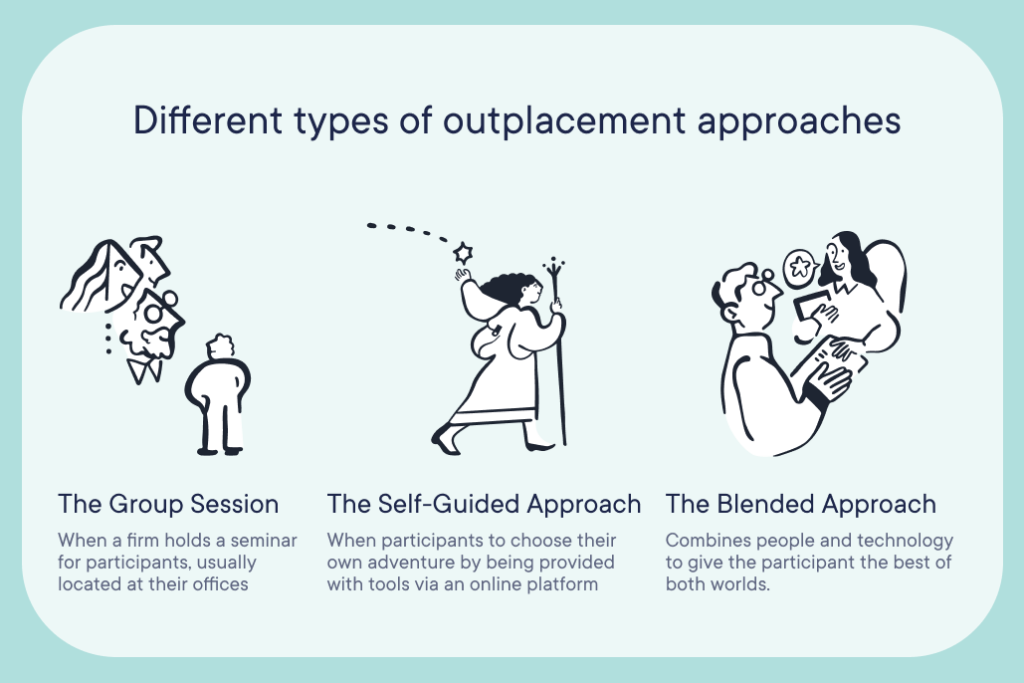
Virtual Outplacement: How Careerminds Blends People and Technology
January 24, 2024 Written by Rebecca Ahn

Compare Providers
Download our outplacement comparison sheet
Request Pricing
Compare our rates to other providers
Given today’s economy and the many companies restructuring, quite a few employees may lose their jobs before their retirement age. This transition can be hard on both the employees and employers. That’s where outplacement services come in.
In this article, we’ll explore how the outplacement industry has evolved with the future of work, shifting to a new virtual outplacement model, and what new challenges, technology, and opportunities that presents.
The Rise of Virtual Outplacement
Outplacement services work with a company and their impacted employees to ensure a smooth transition for all. They help transitioning employees reorient in the job market to find new positions. This happens through services like career guidance, resume writing assistance, career evaluations, interview preparation, networking assistance, and job search support.
Outplacement can also enable the company to retain their top talent and develop new leaders by supporting the remaining employees, especially if they will have to take over additional responsibilities. Outplacement services providers focus on employee retention and career development concerns to keep these employees engaged in the business and ensure a smooth post-transitional period.
Historically, these outplacement services were provided in-person, and often in group settings, at physical locations. However, as technology continues to change every aspect of our society, it has disrupted countless industries over the last decade, including those in the HR space.
Thanks to the recent boom in technology–not to mention the global pandemic–everything that can go virtual, is. There has been a steady increase in demand for remote work and, likewise, for more remote workplace services like outplacement. As a result, the case for virtual outplacement has become increasingly popular.
How Virtual Outplacement Is Changing the Industry
This shift in workplace flexibility and employee work habits continue to translate well into the virtual outplacement model. Technology is changing the outplacement process rapidly. Providers who stick to the traditional outplacement process and don’t embrace technological innovations will not be able to provide the value of service necessary to support clients during times of workforce transition.
The traditional outplacement process consisted of a participant meeting with whichever coach was available at the office during normal business hours and receiving outdated print learning materials. But today’s job seekers demand more flexibility and support than that. Since they are already familiar with a more flexible and virtual workplace, they also work more comfortably in a virtual outplacement environment where career coaching is done over the internet or phone versus in-person.
In the modern world, the outplacement process is flexible, easy to use and understand, and works around a participant’s schedule. There is no need for participants to waste gas, mileage, or unproductive time sitting in traffic. They can log on anytime with any device at any location of their choosing.
The blending of outplacement with technology into virtual outplacement services has made it more affordable and more convenient than traditional outplacement services. This makes it an all around more attractive option for employers and transitioning employees.
In today’s world, the need for speed and on-the-go mindset are the motivating factors for making the virtual outplacement process we use at Careerminds so in demand. Our virtual outplacement approach has evolved into a must have for all companies.
The Right Approach to Virtual Outplacement
There are many different types of outplacement approaches that firms can take to get participants back to work in a new, meaningful role. The history of outplacement is riddled with numerous outplacement approaches.
Let’s review the most prominent of these methods, what they entailed, and how they’ve evolved over time to develop the ideal blended approach for outplacement services that fits with today’s modern workforce.
The Group Session
The first outplacement approach is the group session approach. This method was popular in the early days of outplacement when the internet was still something new.
Essentially, group outplacement is when a firm holds a seminar for participants, usually located at their offices. These offices are generally located in larger cities, meaning that participants would more often than not have to travel to and from these sessions to get support.
While the commute definitely creates a barrier for participants, the real downside to this outplacement approach is that it’s impersonal. When participants are grouped together, they never get the one-on-one support they need. After all, all job searches are different and all take varying amounts of time and planning to succeed.
Outplacement approaches like this one have fallen out of favor largely for this reason. The commute mentioned above becomes an even bigger issue if a participant lives far away, is busy interviewing and cannot make the designated time slot, or perhaps has a second job that is filling the financial hole left by their previous job loss.
In short, the group outplacement approach is too rigid and time-consuming, especially in today’s world where most job searching–and the jobs themselves–happens primarily online.
The Self-Guided Approach
On the other side of that coin is the self-guided virtual outplacement approach, which is the opposite of the group setting approach.
Instead of going into a city to receive support, this approach allows participants to choose their own adventure by providing them with tools via an online platform. While this does have its benefits, such as flexibility with timing and no commuting requirements, it can also be quite impersonal. Perhaps even more so than with the group approach, which still allowed participants to talk face-to-face with an expert and meet their peers going through the program.
The main allure of the self-guided outplacement approach is that it’s often cheaper, which appeals to procurement experts shopping for an outplacement provider. However, that doesn’t mean it is the best solution for those actually going through the process.
The Blended Approach
By far the best method for outplacement is to take a blended approach, combining people and technology to give the participant the best of both worlds. Both the in-person and virtual outplacement, on their own, have their flaws. As you can see in the examples above, the one thing outplacement truly needs to be is personal.
The blended outplacement approach provides dedicated, one-on-one coaching that allows participants to get the support they need no matter what type, level, or seniority they may have. It forgoes the group setting for a more personalized approach that aims to understand the exact needs of each individual, tailoring the process to meet their needs and not the needs of the outplacement provider.
This blended approach also uses the internet to connect people instead of divide them. The internet cancels out the need to commute in order to meet with a coach face-to-face, while also enabling participants to gain access to eLearning tools, social networking, webinars hosted by job search experts, and much more.
This ideal outplacement approach harnesses the power of the internet with the impact of face-to-face coaching (even over video calling). This prevents the outplacement process from feeling less human, gives more control to the participant, cuts their commute times, and–in today’s world–helps keep them safe.
Careerminds Virtual Outplacement: Our Approach
Here at Careerminds, we have been at the forefront of this virtual workplace disruption, continuously adjusting our outplacement process for a more technologically-driven future.
We offer a holistic, virtual outplacement solution that is completely personalized to the participant. Our blended approach takes the best of the methods mentioned above and enhances them with unique offerings and expertise, which have been virtually supporting companies and participants longer than any other outplacement provider.
Setting the Standard for Virtual Outplacement
Careerminds was founded in 2008 as a contemporary provider of global outplacement services. Our innovation was born out of personal experience when, ten years ago, our CEO Raymond Lee was a human resources executive experiencing the downfalls of the traditional outplacement process from the buyer’s perspective. This is what motivated him to develop the technology-based outplacement process methodology that has led Careerminds to become one of the most innovative disruptors in the industry.
Since then, as the rise in demand for remote workplace support has encouraged the outplacement industry to adopt this same approach, our virtual outplacement programs have continued to set the standard in the outplacement industry today.
Blending People and Technology
Our virtual outplacement program combines cutting-edge AI job search technology with personalized, one-on-one career coaching for all job levels–from individual contributors to senior executives–across any geographic location around the world.
Our expert coaches, professional resume writers, and LinkedIn experts work with participants one-on-one to understand their needs and help them put their best foot forward. The participant works with their coach to establish goals and processes that will help them land their next meaningful role or career move.
During this process, the participant continues meeting with their coach, but will also have access to a digital platform packed with tools and resources to help them learn all about the modern-day job search. These include online classes, eLearning tools, webinars, and even a built-in social network that connects fellow job seekers.
The end result is a blended approach that puts people first and uses technology to aid the process by making support easier to receive whenever the participant needs it.
Keeping the Human in Virtual Outplacement
Let’s dive deeper into our people-first approach and what that means. Virtual outplacement often leads people to make assumptions about the quality and personalization of these services. But “virtual” doesn’t have to mean impersonal or generic. The right virtual outplacement service should include the personalized assistance of professional career coaches.
That’s why we at Careerminds provide a blend of accessible virtual resources with highly personalized one-on-one coaching. We make sure our coaches are as industry specific as possible. Someone needing placement in the healthcare industry will have significantly different needs than someone in IT, retail, or financial services.
We also assign coaches as closely to their participants as possible. Different locations can mean different salaries, expectations, and industry standards. The virtual career coach then guides each participant through all steps and services of their tailored program, over whichever medium is easiest for them. This might be over the phone, email, chat, or web-based coaching.
Coaches are responsible to see each participant through the outplacement process. Each transitioning employee will have different needs and different areas of strengths and weaknesses. Our coaches develop a unique and tailored career transition plan, and work with their participants to create the best pathway to placement.
At Careerminds, we believe that when virtual outplacement is done correctly, it combines the best of both worlds. You can have the personalization of a dedicated coach, and the convenience and user-friendly aspects of virtual outplacement tools, resources, and modern technology.
Careerminds Virtual Outplacement: The Technology
Let’s explore what these virtual outplacement tools and resources are in the Careerminds arsenal and how we use technology to deliver unparalleled support to our clients and participants.
The Virtual Platform and eLearning Tools
The virtual platform is the backbone of a virtual outplacement program. It’s where participants go to learn about the process, meet other participants, and much more. At Careerminds, our InMind Portal platform provides a robust experience on both the client and the participant side.
On the client side, our InMind Client Portal includes features such as:
- Participant Management: Upload individual or multiple participants at a time to get them started with the outplacement services.
- Dashboard: View participant status charts, detailed reports, and program success metrics.
- Survey Reports: View participant responses to our career consultant evaluation and exit surveys.
- Job Posting: Post open roles or give recruiters limited platform access to post jobs that participants can see on their end.
- Knowledge Center: Access more resources and helpful FAQs anytime, right at your fingertips.
On the participant side, our eLearning platform uses next-gen AI and machine learning technologies to improve the job search process and make it more accessible than ever before. Participants learn the ins and outs of searching for a new job or career change so that they can better navigate every step of their transition while feeling more confident in doing so.
Our InMind Portal platform also features much more than just training. We provide a networking platform that links all of our participants together as well as former participants who have used our services and landed great jobs. Now they can network with thousands of participants, alumni, recruiters, and career consultants.
Making these connections through our platform even extends beyond Careerminds, as all of our profiles are also connected to LinkedIn. So participants can carry over the connections they make with us into their own personal networks.
Perfect Match and Resume Writing
Our participants also have access to a unique tool called Perfect Match, which allows them to compare their resume to different job descriptions. But it does so much more than that.
For example, it suggests keywords that will optimize a participant’s resume to help get them noticed when they apply to a job. Having the right keywords is essential because many companies use Applicant Tracking Systems (ATS) which filter out any resumes that do not meet certain requirements. This means that many resumes are never even read by a real person.
Our Perfect Match tool helps defeat this issue. By selecting the right keywords and tailoring the resume to the specific job posting, the resume becomes more attractive to the ATS and will improve the chances of the participant getting through the system.
We also utilize this technology to help our participant’s craft their resumes from the very beginning. We don’t just teach them how to write a good resume. We actually write it for them, complete with the right keywords for their targeted role or industry. Essentially, our unique tool takes out a lot of the guesswork that goes into crafting a keyword-optimized resume. By leveraging this technology, participants can spend less time performing keyword switching and more time applying to jobs.
One-on-One Career Coaching
Careerminds took a more virtual approach to outplacement coaching services long before the COVID-19 pandemic. The evolution of how we communicate as a species has allowed virtual outplacement technology to redefine how we help people in a way that, we think, is even better than face-to-face ever was.
While all outplacement services have coaching at their core, our approach focuses on the relationship between the coach and the participant. Every participant gets a dedicated, one-on-one coach who will be with them until they land a new role. In the past, coaching was mainly done by whichever coach was in the office at whatever given time the participant was scheduled. This led to a revolving door of coaches, a lack of personalization and trust, and a resulting loss in progress.
Thankfully those days are mostly over. Given the increase in modern workplace needs and technology, many outplacement providers have now gone remote. Though we at Careerminds have been there from the start. What’s more, our career coaches are the best in the outplacement and coaching industry, and are crucial to the success of our participants.
Unparalleled Support
We make sure to provide our virtual outplacement coaching via high-touch platforms like Zoom or Skype. According to experts, anywhere from 60 to 90 percent of body language is non-verbal. So it’s important that coaching sessions–at least the initial meeting–involve a face-to-face between virtual coach and participant.
Once a relationship is established, coaches and participants can work out the best communication strategy. For example, getting on a Zoom meeting every other day isn’t always feasible, but responding to an email or Skype direct message might be a lot easier. Email is also a powerful tool for sharing content and more thorough conversation that the participant may want to refer back to.
Using a variety of tools to stay connected also helps familiarize participants with these tools, which may prove very useful when interviewing with potential employers. This is why we make sure our participants can benefit from our full scope of online tools, technology, and support methods.
Our “Until Placement” Promise
Careerminds is also unique in how long we work with our participants. Most programs have a limited time frame of one to six months, but these traditional term limits put pressure on participants to land their next role in an arbitrary time frame. However, results are not based on the time spent pursuing them, but rather on outcomes. This is where our “until placement” promise comes in.
“Until placement” means that we will work with participants until they land a new, meaningful role. We do not use term limits and risk cutting off support to participants midway through their transition. Instead, our support is results-focused and outcome-based. It’s not about how much time a person needs, it’s about getting them into their next role no matter what.
A one-size-fits-all approach doesn’t work. All job searches are different, and different people have different needs. So virtual outplacement should be flexible to allow any and all participants to succeed. Our “until placement” promise allows participants of all levels, goals, and tenures to receive the support that they need. This gives our clients a great peace of mind to know that their transitioning employees will be well cared for.
A Truly Tailored Experience
No other provider can match what we offer through our virtual outplacement technology, whether it be our eLearning and networking platform, resume writing, or Perfect Match tool. But don’t take our word for it. Check out our product demo webinars online to see our proprietary platform for yourself.
No two job searches will be alike, so no virtual outplacement services can be successful with a cookie-cutter approach. Our coaches use our full scope of technology, tools, and resources to provide tailored solutions to every participant, along with emotional support, training on bridging the technology gap when one exists, and guidance through every aspect of the job search until they find the right opportunity.
Careerminds Virtual Outplacement: The Benefits
Now that we’ve covered all of the unique technology and tools we offer in our Careerminds virtual outplacement services, we can understand the unique benefits these resources provide for our clients and participants. These are essential elements to look for in any virtual outplacement provider you choose to hire, whether that is Careerminds or another top outplacement firm.
Global Access from Anywhere
Careerminds’ cloud-based approach to outplacement eliminates geographical boundaries and allows clients and participants to receive career support no matter where they live. This means that participants don’t have to spend any of their valuable time traveling to big cities to attend a class or to meet with a coach. Employees from anywhere can now have the same service that was once pinned only to those major cities. It’s an equalizer, and that’s important.
Virtual access also means being able to easily hunt for jobs online, where the job search space exists today. By using online platforms, participants can connect with recruiters, business leaders, and other employees at companies worldwide. Our virtual outplacement offers a larger pool of knowledge and coaches from all parts of the world, with a wider range of experience, all of which participants can use wherever they are to discover new job opportunities wherever they want to go, which is especially helpful if they are trying to transition between locations or regions.
The result is truly global outplacement support, for employees located anywhere who are looking to work anywhere. If a provider doesn’t offer online outplacement services, it’s a signal that they might not be up to the challenge of today’s ever-changing workplace.
24/7 Support at Anytime
Since our virtual outplacement services are entirely web-based, that also means they are available 24 hours per day, 7 days per week, from the comfort of your home or office. This gives clients and participants the flexibility to engage remotely at whatever time is convenient to them, rather than be confined to the standard weekday office hours that most traditional outplacement providers keep.
Our outplacement participants can log into our platform from home while waiting for dinner to come out of the oven. They can attend webinars and work through our learning modules at their convenience. They can access our online job searching tools and optimize their resumes with our Perfect Match technology whenever their schedules allow. Their dedicated coaches can connect with them via phone, email, chat, or video call anytime that works best for them.
The same goes for our clients. Employers have their own online dashboard and support with our InMind Portal, which is accessible to them anytime at their convenience. That’s the beauty of our virtual outplacement platform, combining modern technology with a people-first approach to provide unparalleled access, flexibility, and support.
Services at a More Affordable Price
Virtual outplacement services are cost-effective, meaning they scale and get more affordable the more people use them. So not only can more people benefit from it, but it also saves more time as they do, which in turn saves money. When someone is laid off, they usually get a severance package that contains a lump sum payment, outplacement support, and maybe a few other benefits. However, this lump sum has to last until the person is placed in a new job.
Virtual outplacement is a better, faster, and more affordable alternative to traditional programs. Besides the travel time savings, it also eliminates the cost of printed materials and physical offices. Other programs tend to be cost-prohibitive because of their hefty overhead, and have to impose time constraints to keep their costs down.
All of our Careerminds programs are offered “until placement” and are still usually much less expensive. Our virtual outplacement successfully transitions 95 percent of our active participants in an average of 11.5 weeks from beginning the program to landing their next placement, with an 80 percent participant engagement rate.
The flexibility offered by virtual outplacement support allows employees to live their life without struggling to fit the service into an already stressful calendar. Instead, our services can be used when needed to meet everyone’s unique needs, at scale, saving time and money for both our clients and their participants.
Increased Privacy and Trust
Virtual coaching provides a solution to those who want to keep their career coaching meetings private and confidential. The traditional in-person coaching model did allow for meetings in enclosed office spaces. In today’s virtual world, it can be difficult to get that same experience due to the distractions of working from home.
Careerminds’ virtual coaches prioritize being in a private location so that participants can feel comfortable and confident that they won’t be interrupted by the hustle and bustle of an active household. Our coaches also prioritize being available for virtual calls, so a phone call can become a video call in a few clicks.
This flexibility allows participants to get the support they need when they need it, with the assurance that they can be open and honest with their coach no matter what their career goals and aspirations.
Stronger Virtual Relationships
In the same vein, it can be difficult to provide feedback and guide participants if you don’t know them. Our Careerminds coaches take the time to get to know the people using our services, not just their work experience. They do this by asking questions, empathizing with anxieties, and learning more about their life so they can best help them find the perfect job for their situation.
Building this relationship also lets our participants be their most authentic selves. Trying to communicate with a virtual coach who doesn’t create a safe and understanding space can lead participants to hold back, which can delay finding the perfect placement.
Finding a job is always a personal matter. So coaching needs to go beyond simply getting a new job. It has to extend to how the participant sees their ideal lifestyle, their personal lives, and much more. Finding a job is one thing. Finding the perfect job is another story, and it’s what we strive to do every day.
Customized Training
Careerminds’ virtual outplacement allows participants to customize their training to their unique needs and goals. They can receive resume writing support, profile optimization, job searching, personality and career assessments, and custom career coaching via a variety of virtual methods, tools, and training.
Our virtual outplacement platform also includes resources that let participants further explore knowledge areas that are relevant to their particular career. They can learn at their own pace, without feeling the pressure to move on too quickly or linger too long on the various learning materials, giving them all the time they need to fully comprehend new training and tools.
What’s more, an online platform allows the experience to be more fun and interesting. Virtual outplacement combines readings, graphics, video and audio, interactive exercises, and case studies to keep participants engaged with the materials and meet the needs of multiple learning styles.
Virtual Outplacement: Final Takeaway
In the end, there are many approaches and elements to consider when shopping for virtual outplacement services. The best option is the one that will take into account the unique needs of your employees and provide each of them with a personalized, accessible experience whatever their career goals, timeframe, finances, location, and tech-savvy skills.
Virtual outplacement needs to be personal and easy to access. If it is not personalized, participants may not receive the correct level of support or may receive support in the wrong areas, which is a waste of precious time. If it isn’t easily accessible, participants may not end up using the program, which is a waste of time and money.
Our blended approach at Careerminds is the best bet for the modern-day job seeker. It enables a people-first approach that is backed by modern technology to eliminate barriers that have long plagued the outplacement space.
Want to learn more about our Careerminds virtual outplacement services? We’d love to talk:
In need of outplacement assistance?
At Careerminds, we care about people first. That’s why we offer personalized talent management solutions for every level at lower costs, globally.




